Effect of Direct Reduction Treatment on Pt–Sn/Al2O3 Catalyst for Propane Dehydrogenation
Abstract
:1. Introduction
2. Results
2.1. Catalyst Performance
2.2. Catalyst Characterization
2.2.1. X-ray Diffraction Analysis
2.2.2. TEM
2.2.3. DTA Analysis
2.2.4. XPS Analysis
3. Discussion
4. Materials and Methods
4.1. Catalyst Preparation
4.2. Catalytic Activity Measurements
4.3. Characterization
5. Conclusions
Author Contributions
Funding
Conflicts of Interest
References
- Sattler, J.J.H.B.; Ruiz-Martinez, J.; Santillan-Jimenez, E.; Weckhuysen, B.M. Catalytic dehydrogenation of light alkanes on metals and metal oxides. Chem. Rev. 2014, 114, 10613–10653. [Google Scholar] [CrossRef] [PubMed]
- Nawaz, Z. Light alkane dehydrogenation to light olefin technologies: A comprehensive review. Rev. Chem. Eng. 2015, 31, 413–436. [Google Scholar] [CrossRef]
- Vu, B.K.; Song, M.B.; Ahn, I.Y.; Suh, Y.W.; Suh, D.J.; Kim, W.I.; Koh, H.L.; Choi, Y.G.; Shin, E.W. Pt–Sn alloy phases and coke mobility over Pt–Sn/Al2O3and Pt–Sn/ZnAl2O4catalysts for propane dehydrogenation. Appl. Catal. A Gen. 2011, 400, 25–33. [Google Scholar] [CrossRef]
- Seo, H.; Kwon, J.; Gi, U.; Park, G.; Yoo, Y.; Lee, J.; Chang, H.; Kyu, I. Direct dehydrogenation of n-butane over Pt/Sn/M/γ-Al2O3 catalysts: Effect of third metal (M) addition. CATCOM 2014, 47, 22–27. [Google Scholar] [CrossRef]
- Iglesias-Juez, A.; Beale, A.M.; Maaijen, K.; Weng, T.C.; Glatzel, P.; Weckhuysen, B.M. A combined in situ time-resolved UV-Vis, Raman and high-energy resolution X-ray absorption spectroscopy study on the deactivation behavior of Pt and PtSn propane dehydrogenation catalysts under industrial reaction conditions. J. Catal. 2010, 276, 268–279. [Google Scholar] [CrossRef]
- Lee, H.; Kim, W.I.; Jung, K.D.; Koh, H. Effect of Cu promoter and alumina phases on Pt/Al2O3 for propane dehydrogenation. Korean J. Chem. Eng. 2017, 34, 1337–1345. [Google Scholar] [CrossRef]
- Shan, Y.; Sui, Z.; Zhu, Y.; Chen, D.; Zhou, X. Effect of steam addition on the structure and activity of Pt–Sn catalysts in propane dehydrogenation. Chem. Eng. J. 2015, 278, 240–248. [Google Scholar] [CrossRef]
- Hauser, A.W.; Gomes, J.; Bajdich, M.; Head-Gordon, M.; Bell, A.T. Subnanometer-sized Pt/Sn alloy cluster catalysts for the dehydrogenation of linear alkanes. Phys. Chem. Chem. Phys. 2013, 15, 20727–20734. [Google Scholar] [CrossRef]
- Zhu, H.; Anjum, D.H.; Wang, Q.; Abou-Hamad, E.; Emsley, L.; Dong, H.; Laveille, P.; Li, L.; Samal, A.K.; Basset, J. Sn surface-enriched Pt – Sn bimetallic nanoparticles as a selective and stable catalyst for propane dehydrogenation. J. Catal. 2014, 320, 52–62. [Google Scholar] [CrossRef]
- Deng, L.; Shishido, T.; Teramura, K.; Tanaka, T. Effect of reduction method on the activity of Pt–Sn/SiO2 for dehydrogenation of propane. Catal. Today 2014, 232, 33–39. [Google Scholar] [CrossRef]
- Pham, H.N.; Anderson, A.E.; Johnson, R.L.; Schwartz, T.J.; O’Neill, B.J.; Duan, P.; Schmidt-Rohr, K.; Dumesic, J.A.; Datye, A.K. Carbon Overcoating of Supported Metal Catalysts for Improved Hydrothermal Stability. ACS Catal. 2015, 5, 4546–4555. [Google Scholar] [CrossRef]
- Bhasin, M.M.; McCain, J.H.; Vora, B.V.; Imai, T.; Pujadó, P.R. Dehydrogenation and oxydehydrogenation of paraffins to olefins. Appl. Catal. A Gen. 2001, 221, 397–419. [Google Scholar] [CrossRef]
- Larese, C.; Campos-Martin, J.M.; Calvino, J.J.; Blanco, G.; Fierro, J.L.G.; Kang, Z.C. Alumina- and Alumina–Zirconia-Supported PtSn Bimetallics: Microstructure and Performance for the n-Butane ODH Reaction. J. Catal. 2002, 208, 467–478. [Google Scholar] [CrossRef]
- Zhang, Y.; Zhou, Y.; Yang, K.; Li, Y.; Wang, Y.; Xu, Y.; Wu, P. Effect of hydrothermal treatment on catalytic properties of PtSnNa/ZSM-5 catalyst for propane dehydrogenation. Microporous Mesoporous Mater. 2006, 96, 245–254. [Google Scholar] [CrossRef]
- Huang, L.; Xu, B.; Yang, L.; Fan, Y. Propane dehydrogenation over the PtSn catalyst supported on alumina-modified SBA-15. Catal. Commun. 2008, 9, 2593–2597. [Google Scholar] [CrossRef]
- Del Angel, G.; Bonilla, A.; Peña, Y.; Navarrete, J.; Fierro, J.L.G.; Acosta, D.R. Effect of lanthanum on the catalytic properties of PtSn/γ-Al2O3 bimetallic catalysts prepared by successive impregnation and controlled surface reaction. J. Catal. 2003, 219, 63–73. [Google Scholar] [CrossRef]
- Zangeneh, F.T.; Mehrazma, S.; Sahebdelfar, S. The influence of solvent on the performance of Pt–Sn/θ-Al2O3 propane dehydrogenation catalyst prepared by co-impregnation method. Fuel Process. Technol. 2013, 109, 118–123. [Google Scholar] [CrossRef]
- Vu, B.K.; Song, M.B.; Ahn, I.Y.; Suh, Y.W.; Suh, D.J.; Kim, W. Il; Koh, H.L.; Choi, Y.G.; Shin, E.W. Propane dehydrogenation over Pt–Sn/Rare-earth-doped Al2O3: Influence of La, Ce, or Y on the formation and stability of Pt–Sn alloys. Catal. Today 2011, 164, 214–220. [Google Scholar] [CrossRef]
- Kikuchi, I.; Ohshima, M.; Kurokawa, H.; Miura, H. Effect of Sn Addition on n-Butane Dehydrogenation over Alumina-supported Pt Catalysts Prepared by Co-impregnation and Sol-gel Methods. J. Jpn Pet. Inst. 2012, 55, 206–213. [Google Scholar] [CrossRef]
- Praserthdam, P.; Grisdanurak, N.; Yuangsawatdikul, W. Coke formation over Pt–Sn-K/Al2O3 in C3, C5-C8 alkane dehydrogenation. Chem. Eng. J. 2000, 77, 215–219. [Google Scholar] [CrossRef]
- Deng, L.; Miura, H.; Shishido, T.; Hosokawa, S.; Teramura, K.; Tanaka, T. Dehydrogenation of propane over silica-supported platinum-tin catalysts prepared by direct reduction: Effects of tin/platinum ratio and reduction temperature. ChemCatChem 2014, 6, 2680–2691. [Google Scholar] [CrossRef]
- Deng, L.; Miura, H.; Shishido, T.; Wang, Z.; Hosokawa, S.; Teramura, K.; Tanaka, T. Elucidating strong metal-support interactions in Pt–Sn/SiO2catalyst and its consequences for dehydrogenation of lower alkanes. J. Catal. 2018, 365, 277–291. [Google Scholar] [CrossRef]
- Hee Kim, G.; Jung, K.-D.; Kim, W.-I.; Um, B.-H.; Shin, C.-H.; Oh, K.; Lim Koh, H. Effect of oxychlorination treatment on the regeneration of Pt–Sn/Al2O3 catalyst for propane dehydrogenation. Res. Chem. Intermed. 2015, 42. [Google Scholar] [CrossRef]
- Deng, L.; Arakawa, T.; Ohkubo, T.; Miura, H.; Shishido, T.; Hosokawa, S.; Teramura, K.; Tanaka, T. Highly Active and Stable Pt−Sn/SBA-15 Catalyst Prepared by Direct Reduction for Ethylbenzene Dehydrogenation: E ff ects of Sn Addition. Ind. Eng. Chem. Res. 2017, 56, 7160–7172. [Google Scholar] [CrossRef]
- Arteaga, G.J.; Anderson, J.A.; Becker, S.M.; Rochester, C.H. Influence of oxychlorination treatment on the surface and bulk properties of a Pt–Sn/Al2O3 catalyst. J. Mol. Catal. A Chem. 1999, 145, 183–201. [Google Scholar] [CrossRef]
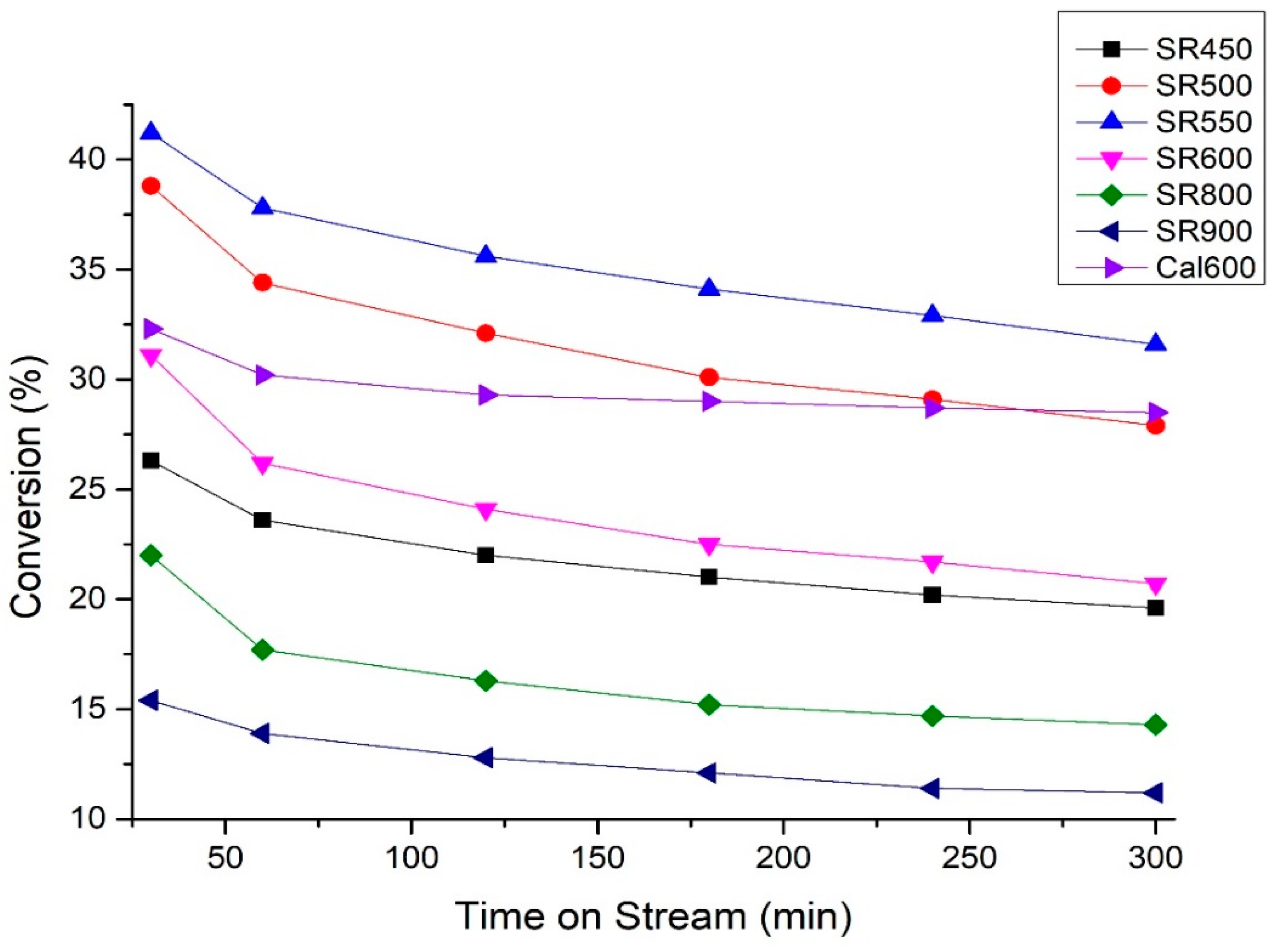
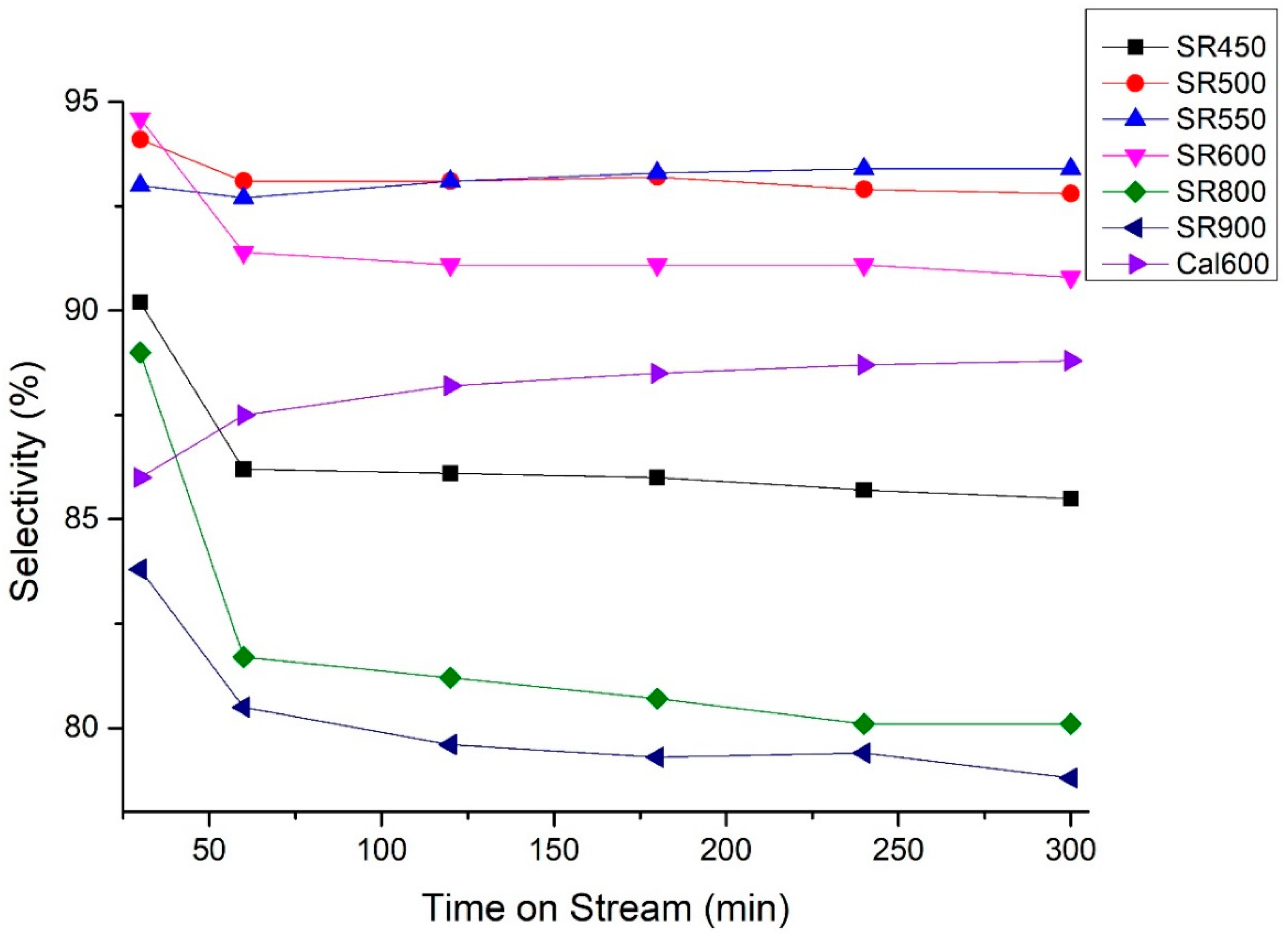
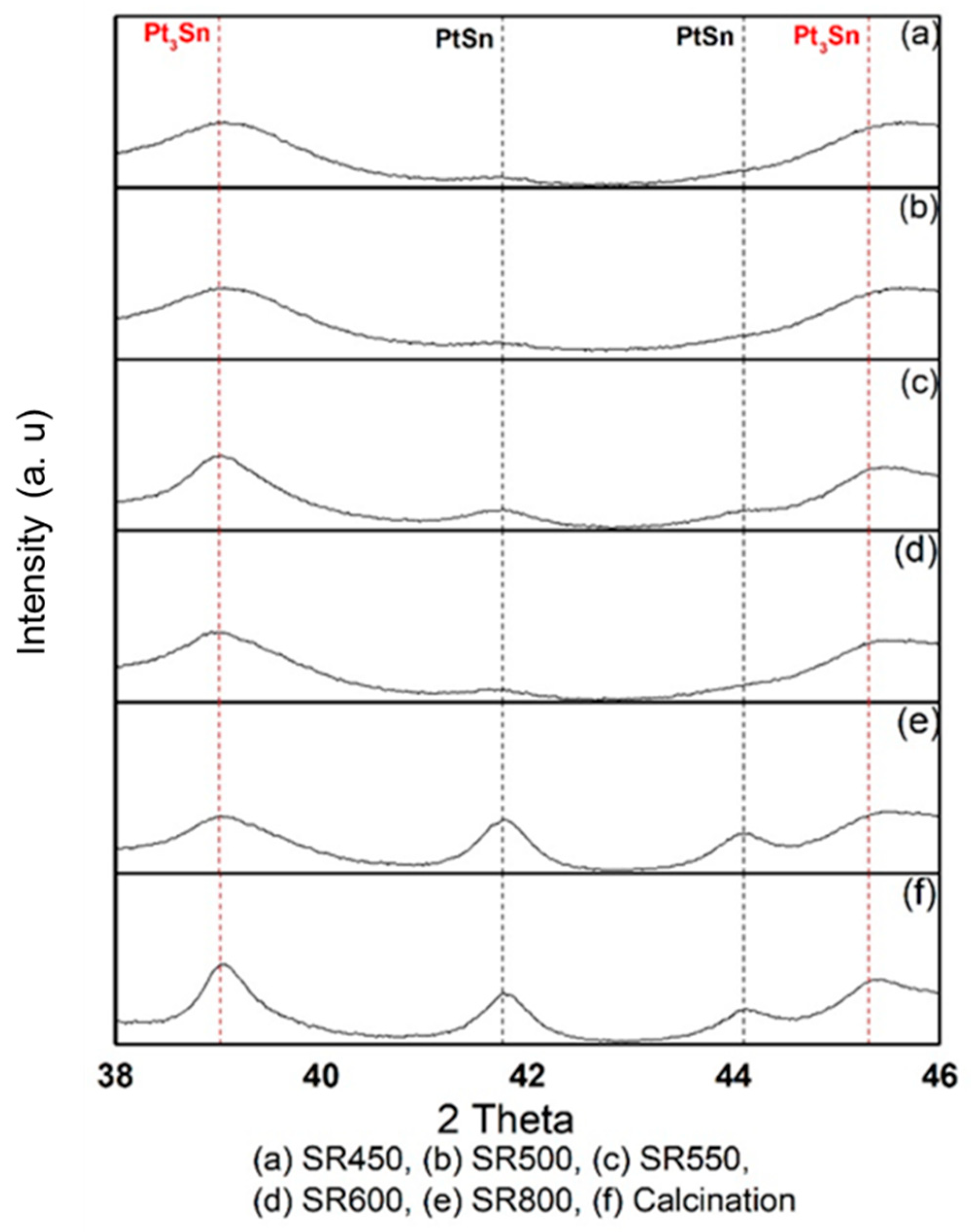
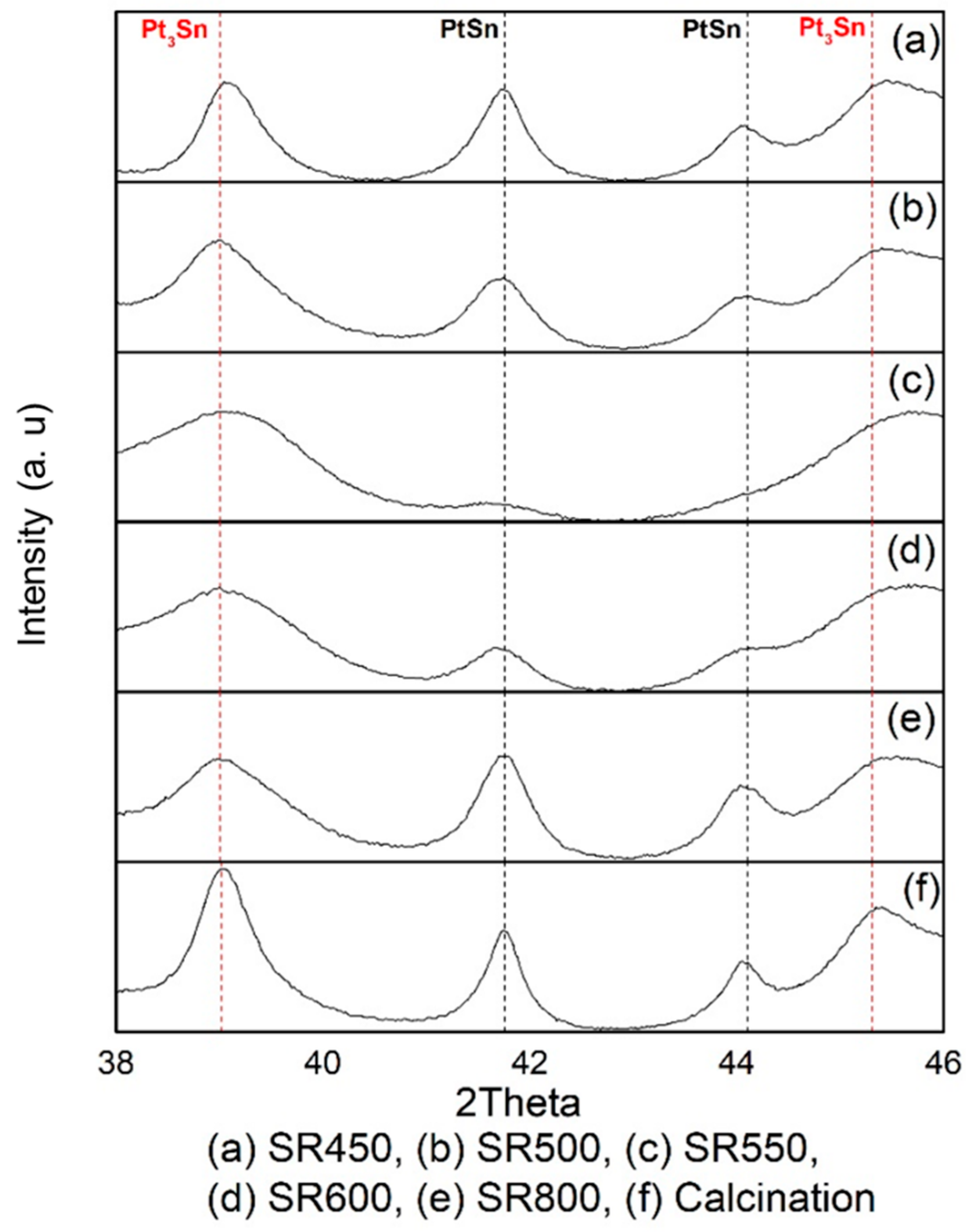
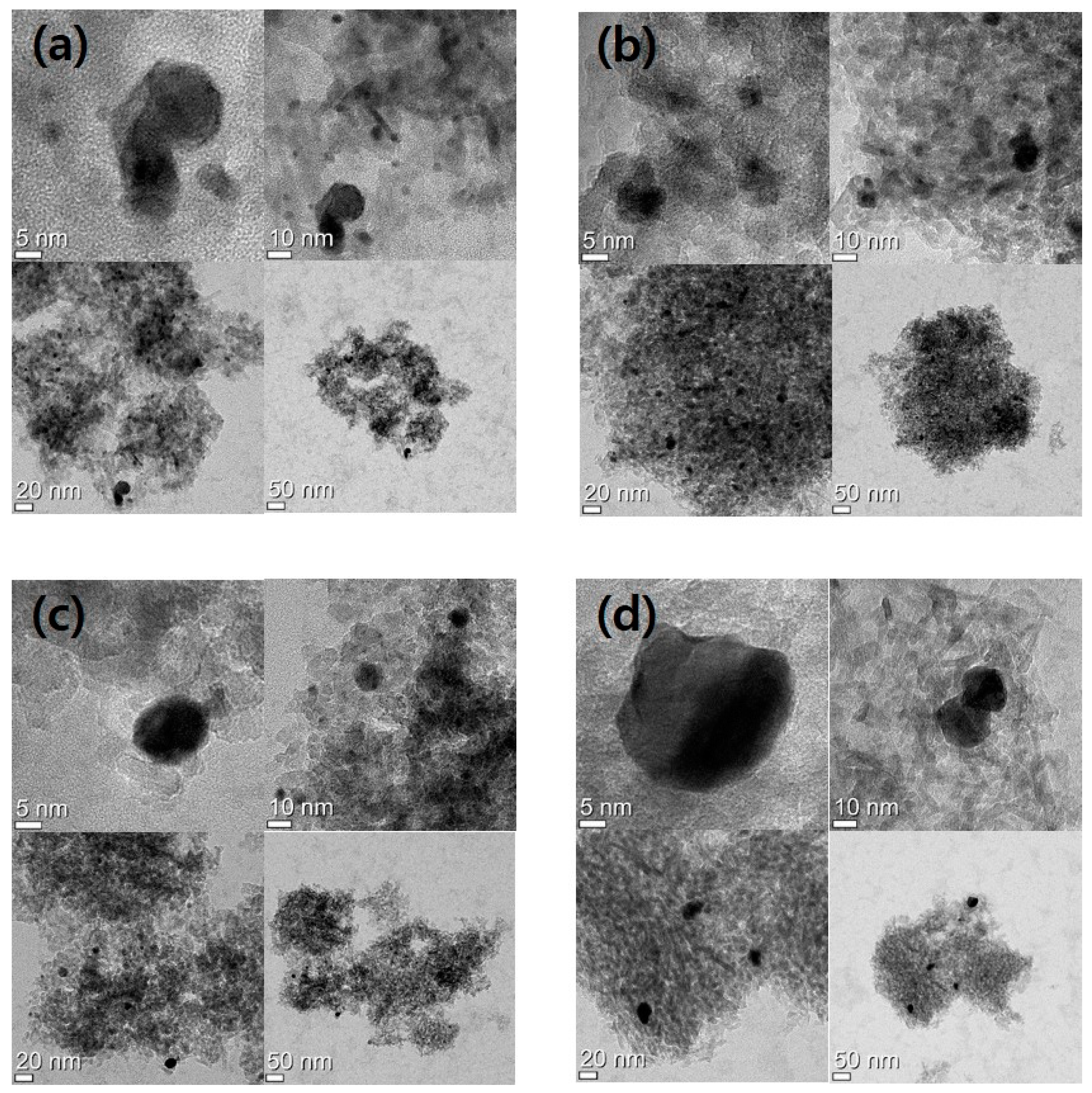
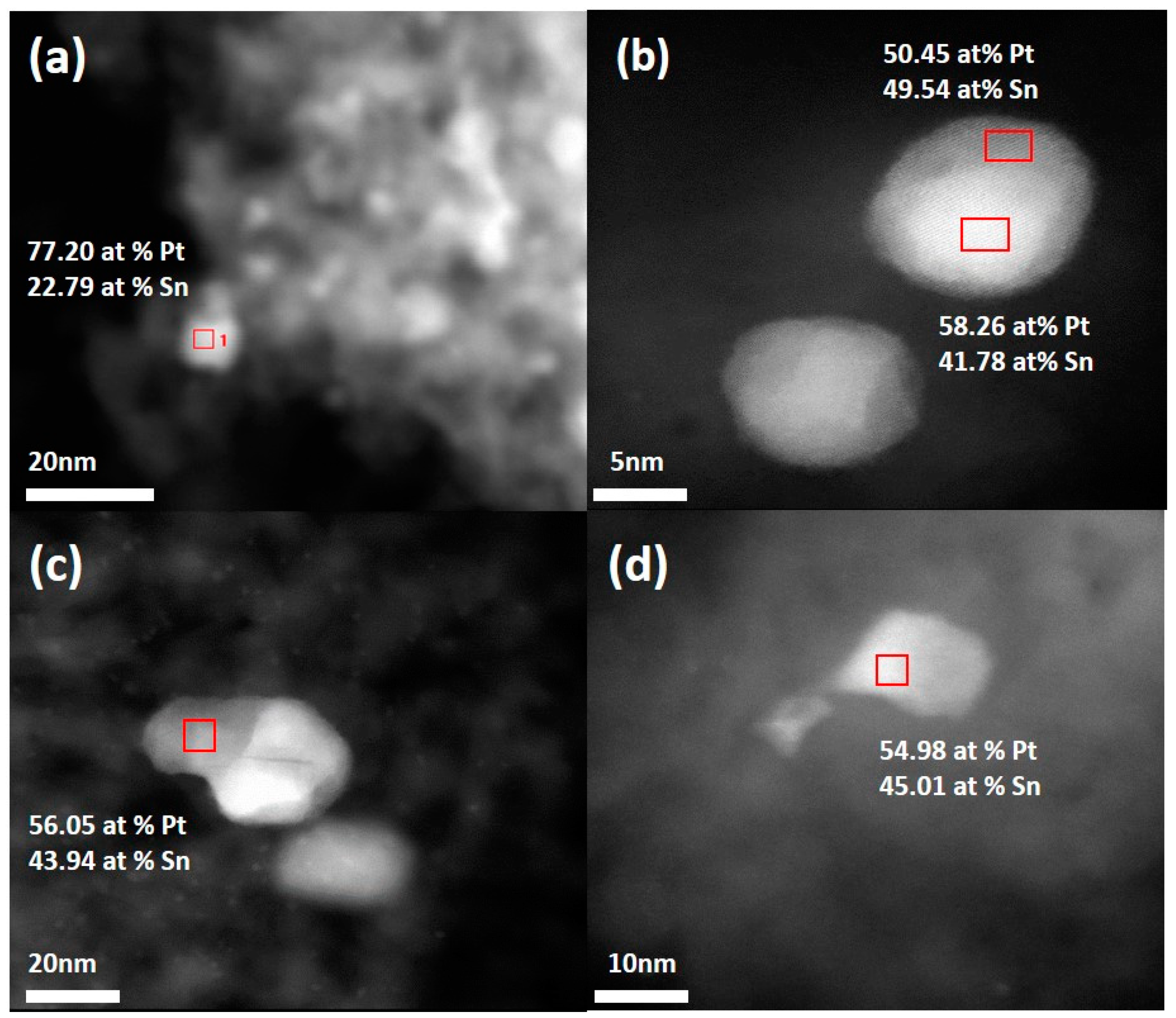
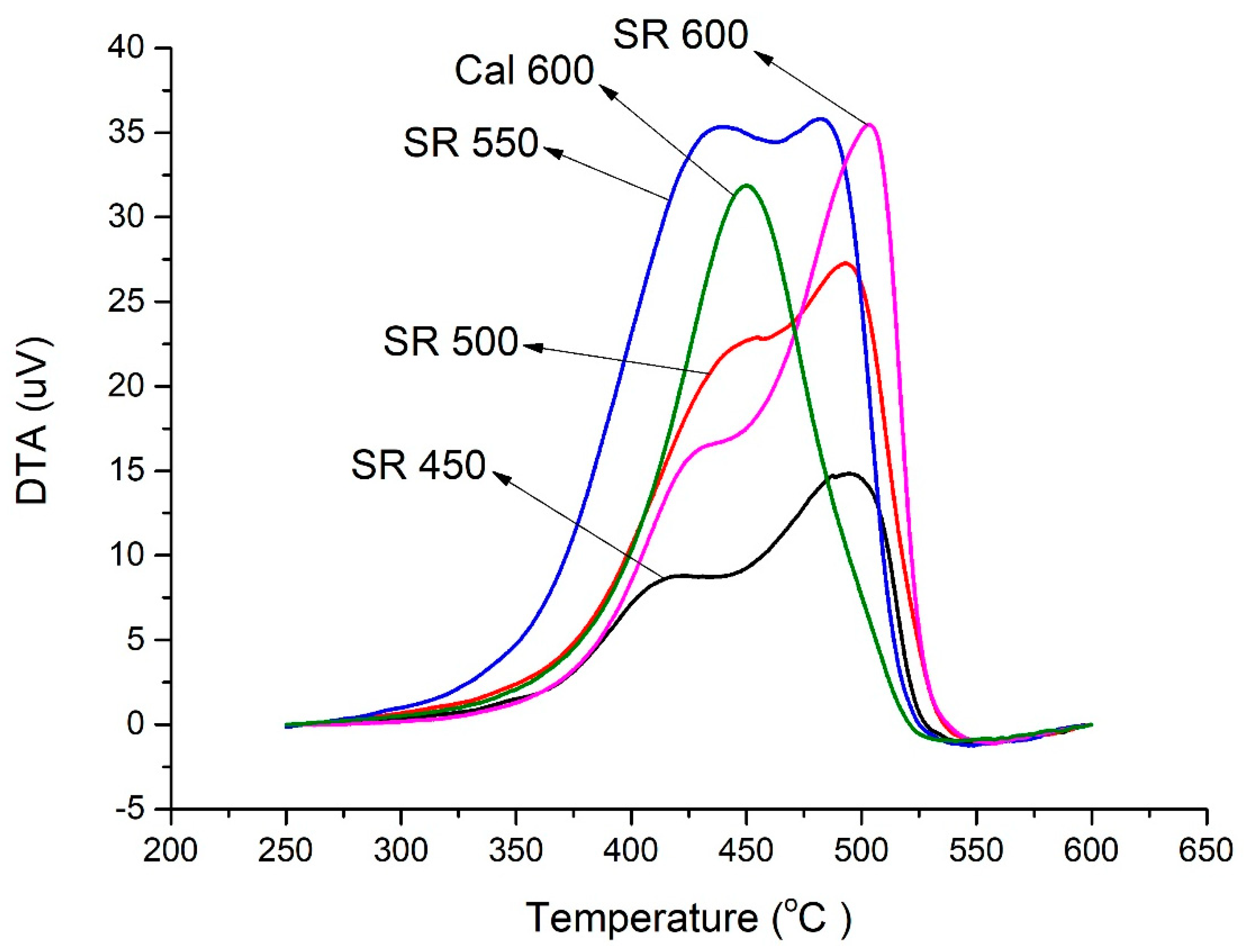

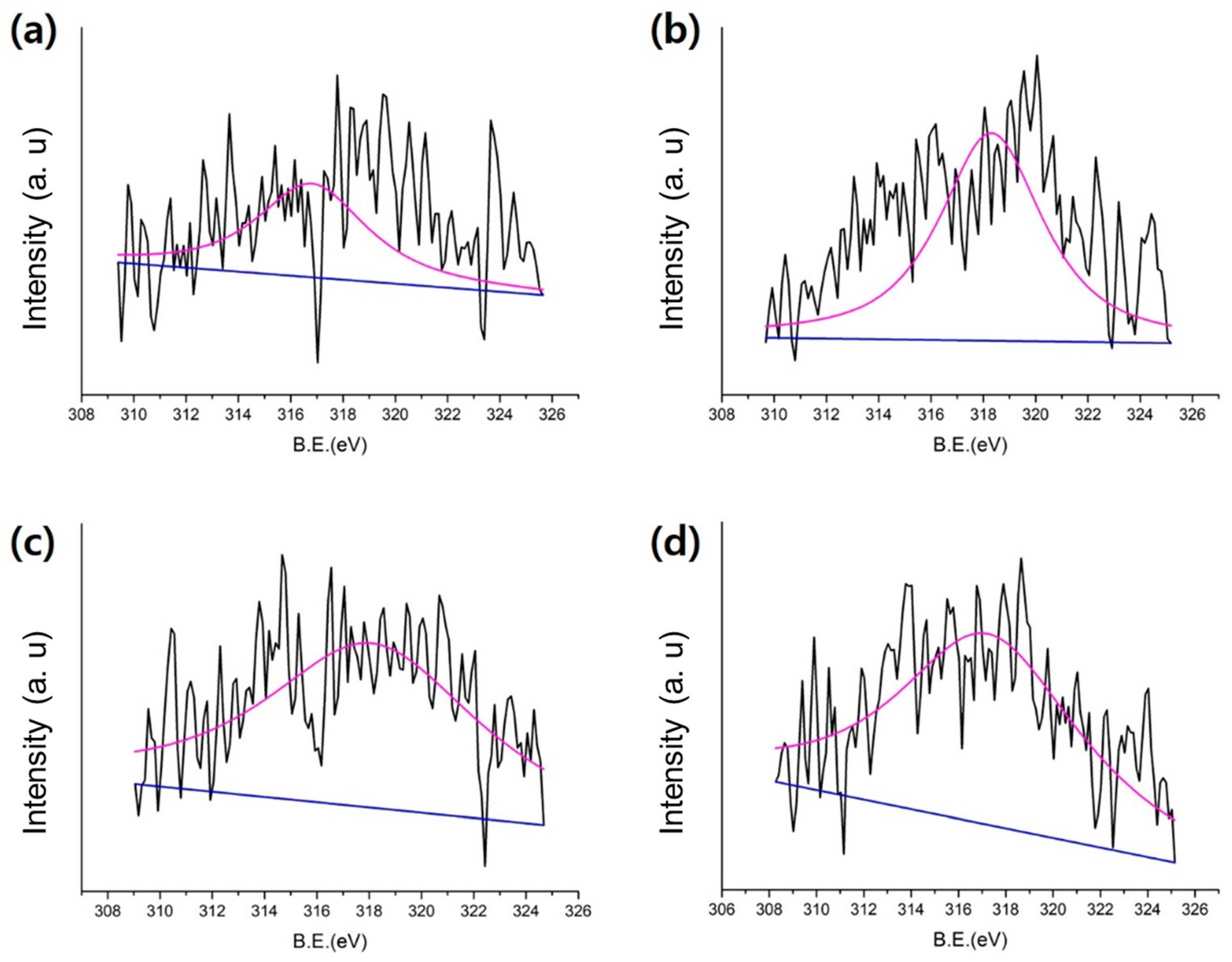
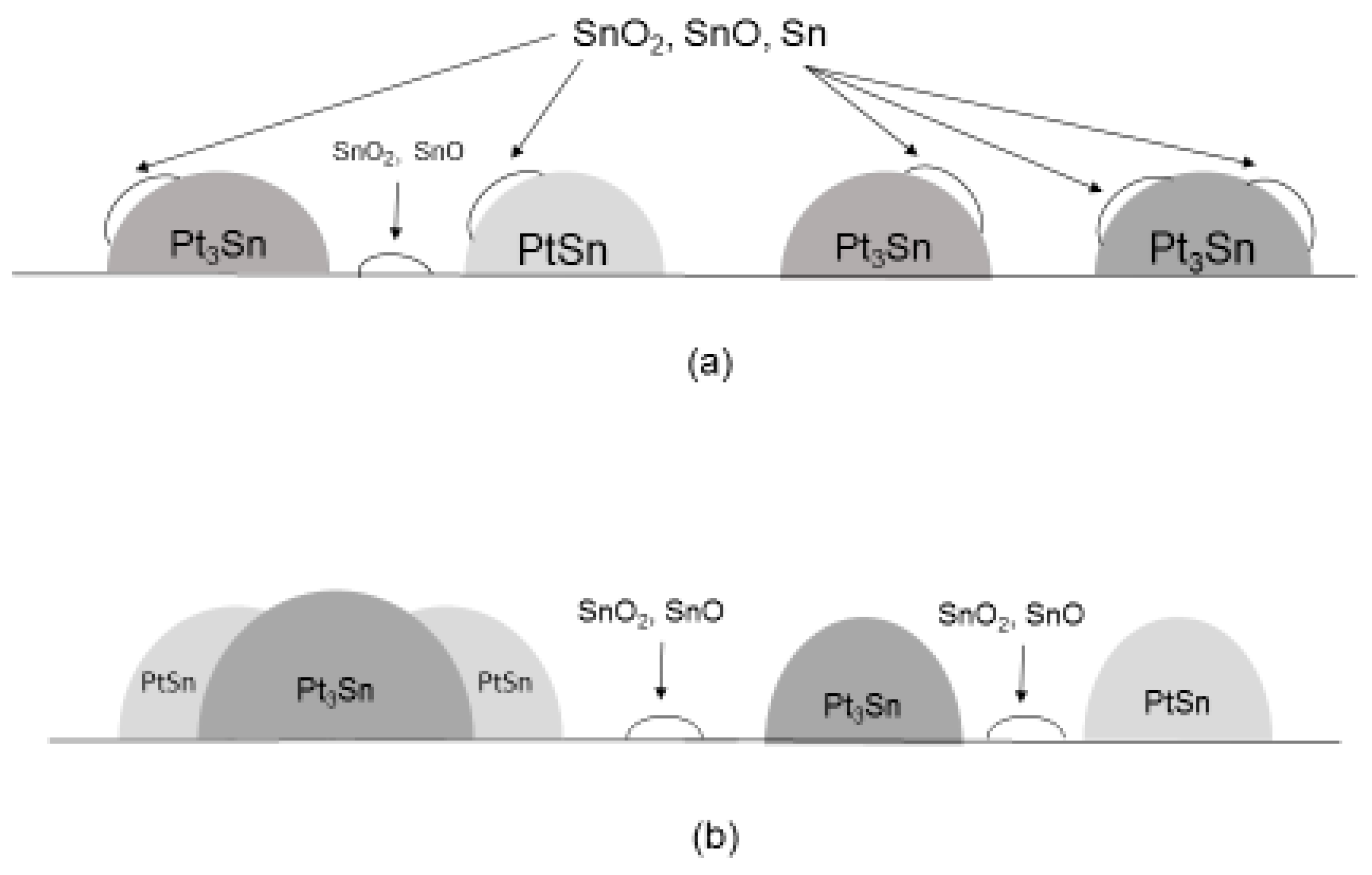
| Catalyst | XRD (IPt3Sn/IPtSn) After Preparation | XRD (IPt3Sn/IPtSn) After Reduction | XRD (IPt3Sn/IPtSn) After Reaction | Coke (wt.%) |
|---|---|---|---|---|
| SR450 | 9.15 | 1.08 | 1.58 | 5.85 |
| SR500 | 5.16 | 1.55 | 1.58 | 7.86 |
| SR550 | 4.12 | 7.79 | 2.33 | 8.60 |
| SR600 | 6.97 | 2.48 | 3.21 | 7.04 |
| Cal600 | 1.62 | 1.63 | 1.54 | 4.00 |
© 2019 by the authors. Licensee MDPI, Basel, Switzerland. This article is an open access article distributed under the terms and conditions of the Creative Commons Attribution (CC BY) license (http://creativecommons.org/licenses/by/4.0/).
Share and Cite
Jung, J.-W.; Kim, W.-I.; Kim, J.-R.; Oh, K.; Koh, H.L. Effect of Direct Reduction Treatment on Pt–Sn/Al2O3 Catalyst for Propane Dehydrogenation. Catalysts 2019, 9, 446. https://doi.org/10.3390/catal9050446
Jung J-W, Kim W-I, Kim J-R, Oh K, Koh HL. Effect of Direct Reduction Treatment on Pt–Sn/Al2O3 Catalyst for Propane Dehydrogenation. Catalysts. 2019; 9(5):446. https://doi.org/10.3390/catal9050446
Chicago/Turabian StyleJung, Jae-Won, Won-Il Kim, Jeong-Rang Kim, Kyeongseok Oh, and Hyoung Lim Koh. 2019. "Effect of Direct Reduction Treatment on Pt–Sn/Al2O3 Catalyst for Propane Dehydrogenation" Catalysts 9, no. 5: 446. https://doi.org/10.3390/catal9050446
APA StyleJung, J.-W., Kim, W.-I., Kim, J.-R., Oh, K., & Koh, H. L. (2019). Effect of Direct Reduction Treatment on Pt–Sn/Al2O3 Catalyst for Propane Dehydrogenation. Catalysts, 9(5), 446. https://doi.org/10.3390/catal9050446





